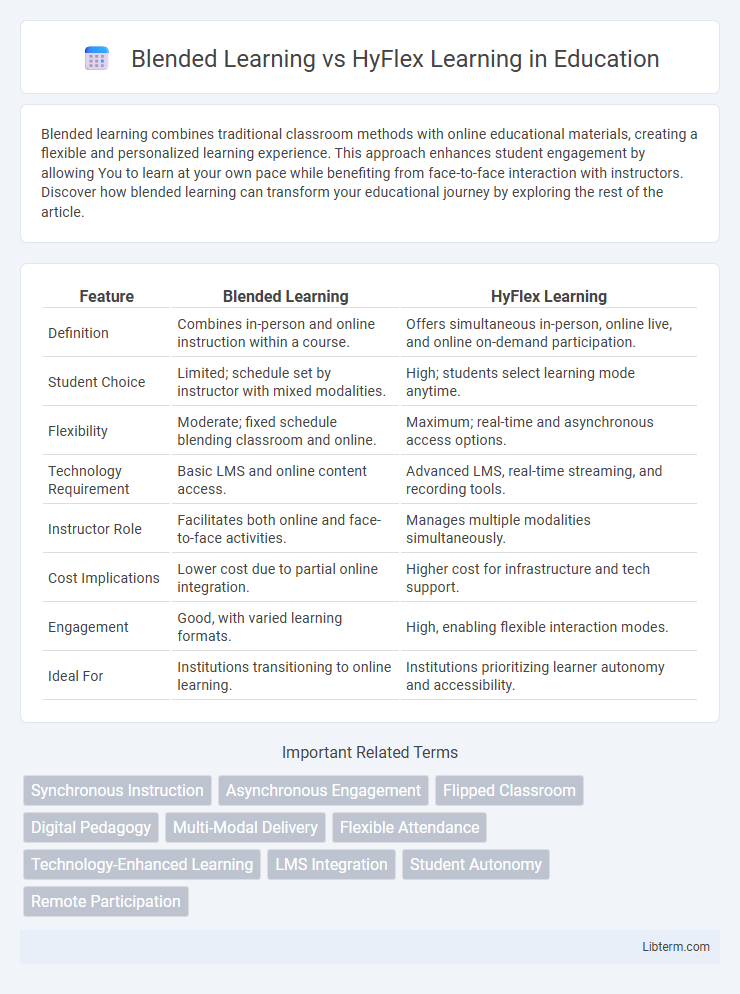Blended learning combines traditional classroom methods with online educational materials, creating a flexible and personalized learning experience. This approach enhances student engagement by allowing You to learn at your own pace while benefiting from face-to-face interaction with instructors. Discover how blended learning can transform your educational journey by exploring the rest of the article.
Table of Comparison
| Feature | Blended Learning | HyFlex Learning |
|---|---|---|
| Definition | Combines in-person and online instruction within a course. | Offers simultaneous in-person, online live, and online on-demand participation. |
| Student Choice | Limited; schedule set by instructor with mixed modalities. | High; students select learning mode anytime. |
| Flexibility | Moderate; fixed schedule blending classroom and online. | Maximum; real-time and asynchronous access options. |
| Technology Requirement | Basic LMS and online content access. | Advanced LMS, real-time streaming, and recording tools. |
| Instructor Role | Facilitates both online and face-to-face activities. | Manages multiple modalities simultaneously. |
| Cost Implications | Lower cost due to partial online integration. | Higher cost for infrastructure and tech support. |
| Engagement | Good, with varied learning formats. | High, enabling flexible interaction modes. |
| Ideal For | Institutions transitioning to online learning. | Institutions prioritizing learner autonomy and accessibility. |
Introduction to Blended Learning and HyFlex Learning
Blended learning integrates traditional face-to-face classroom instruction with online educational content, offering flexibility and personalized pacing for students. HyFlex learning expands on this model by providing students the option to attend classes in person, synchronously online, or asynchronously, adapting to diverse learner preferences and schedules. Both approaches leverage technology to enhance engagement, yet HyFlex uniquely supports simultaneous multimodal participation.
Defining Blended Learning
Blended learning combines traditional face-to-face instruction with online educational activities, creating a cohesive learning experience that leverages both in-person and digital platforms. This approach integrates synchronous and asynchronous methods to enhance flexibility, engagement, and accessibility for diverse learners. Blended learning environments utilize multimedia resources, collaborative tools, and real-time feedback to optimize student outcomes and accommodate various learning preferences.
Understanding HyFlex Learning
HyFlex learning integrates both face-to-face and online modalities, allowing students to choose their mode of participation on a session-by-session basis, which enhances flexibility and accessibility. This model supports synchronous and asynchronous engagement through interactive technologies, ensuring equitable learning experiences regardless of location. HyFlex's adaptive structure contrasts with traditional blended learning by offering real-time decision-making autonomy to students without compromising instructional quality.
Key Differences Between Blended and HyFlex Learning
Blended learning combines online digital media with traditional in-person classroom methods where students attend physically or virtually in a fixed schedule, while HyFlex learning offers students the flexibility to choose their mode of attendance--online or face-to-face--on a session-by-session basis. Unlike blended learning, HyFlex courses require technology infrastructure to support synchronous participation with seamless interaction between both online and in-person students. The core difference lies in HyFlex's emphasis on learner choice and real-time engagement across modalities, whereas blended learning follows a predetermined integration of online and offline components.
Benefits of Blended Learning
Blended learning combines traditional face-to-face instruction with online educational materials, enhancing flexibility and accessibility for students while maintaining personal interaction. It promotes active learning through diverse instructional methods, catering to various learning styles and improving student engagement and retention. Research indicates that blended learning environments can lead to higher academic performance and better skill development compared to purely online or traditional models.
Advantages of HyFlex Learning
HyFlex learning offers unparalleled flexibility by allowing students to choose between attending classes in-person or online, catering to diverse learning preferences and schedules. This model enhances student engagement and accessibility, providing synchronous and asynchronous participation options that accommodate different time zones and personal commitments. By integrating digital tools with face-to-face interaction, HyFlex learning supports personalized education and fosters a collaborative, inclusive learning environment.
Challenges in Implementing Blended Learning
Implementing blended learning faces challenges such as ensuring equitable access to technology and reliable internet for all students, which can hinder participation and engagement. Instructors often require extensive training to effectively design and deliver course content that seamlessly integrates online and face-to-face components. Balancing in-person and digital interactions to maintain student motivation and personalized learning experiences remains a significant obstacle for educational institutions.
Challenges in Adopting HyFlex Learning
Adopting HyFlex learning poses challenges such as increased demands on instructors to simultaneously manage in-person and online students while maintaining engagement across both environments. Technological infrastructure and reliable internet connectivity are critical yet often inconsistent, creating barriers to seamless content delivery and interaction. Furthermore, institutions must address training gaps and resource allocation to support effective implementation and overcome resistance to pedagogical change.
Choosing the Right Approach for Your Educational Needs
Blended learning combines traditional face-to-face instruction with online components, offering a structured schedule that suits learners who benefit from direct interaction and digital flexibility. HyFlex learning provides the highest level of adaptability by allowing students to choose between attending classes in-person, participating online synchronously, or engaging asynchronously. Selecting the right approach depends on factors such as course objectives, student preferences, technological infrastructure, and the desired balance between flexibility and instructor presence.
Future Trends in Flexible Learning Models
Blended learning integrates traditional face-to-face instruction with online components, offering structured flexibility that enhances student engagement and resource accessibility. HyFlex learning expands on this by allowing students to choose their mode of participation--on-campus, online synchronous, or online asynchronous--catering to diverse learning preferences and schedules. Future trends indicate an increased adoption of AI-driven adaptive technologies and data analytics in both models to personalize learning experiences and support scalable, flexible education frameworks.
Blended Learning Infographic

 libterm.com
libterm.com